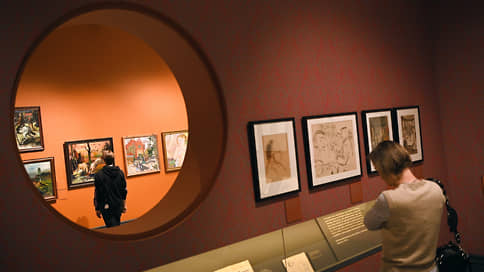The exhibition “Group 13” opened at the Museum of Russian Impressionism
[ad_1]

An impressive exhibition entitled “Group “13” has opened at the Museum of Russian Impressionism. In the alleys of the era,” dedicated to one of the strangest artistic groups of the turn of the 1920s and 1930s. Tells Alexey Mokrousov.
The group “13” included many artists, but two exhibitions had 13 participants, although there was one more that never opened. As a result, the biographical dictionary in the catalog of the new exhibition of the Museum of Russian Impressionism contains 31 names.
As part of a large project, the Bolshevik factory collected 360 exhibits from many Russian museums, from Arkhangelsk to Taganrog, and private collections. This is how a portrait of a group emerges, because of which the history of Soviet art cannot be rewritten, but the history of the Soviet era can be seen in a new way. There are not so many artists who participated in all the exhibitions – the founders of the “committee “13”” were Vladimir Milashevsky, Nikolai Kuzmin, Daniil Daran, and Boris Rybchenkov and Tatyana Mavrina, who joined them in 1930. They were united by the idea of unity of tempo and unity of material, the desire to capture everyday life in a drawing made quickly and using the same technique, without preliminary work and later amendments.
Unlike colleagues who focus on the heroes of their retrospective, curator Nadezhda Plungyan is interested in context. In the halls, graphics and paintings by the authors of “13” coexist with the heritage of French authors. Drawings by Gericault and Millet, paintings by Gleizes and Vlaminck are placed against a special background, but only in one case are these intrusions accompanied by a direct quote from the artist confirming that it was this particular painting that he saw. The French influence permeated the work of many; it is no coincidence that in Olga Hildebrandt’s watercolor, given to a colleague in 1933, the dedication begins with “To Daran the French…”, and Tatiana Mavrina’s diaries are full of French names.
The love for French is also felt in the illustrations – the main calling card of “13”. There are many books in the halls, primarily from the legendary Academia publishing house; the Goncourt brothers, Balzac, Anatole France – and not a single German writer. Even in this choice one could feel the opposition of the “picturesque” line of “13” to the rigid graphic drawings of the Society of Easel Painters, whose style was defined by contemporaries as “German”.
The stories of the group “13” are a hymn to everyday life. The life of the circus, the everyday life of the hippodrome, dancers and home feasts, the silence of Moscow streets, rare cab drivers… The title “In the Lanes of the Era” is extremely accurate, there is no place for sun-drenched avenues, marches from loudspeakers and cheerful athletes. Maybe the members of “13” were simply trying not to notice modernity? But you can’t even suspect them of wanting to oppose Soviet power in any way; they are just trying to look at the new life through the eyes of a free person. Many – Kuzmin, Milashevsky, Daran, Sergei Rastorguev – come from the editorial circle of the Gudok newspaper, where Mikhail Bulgakov, Ilya Ilf and Yuri Olesha worked over the years.
In total, three “13” exhibitions were prepared; the second one was closed without opening. Is this due to the eclectic nature of the movement, which aesthetically spread after the former members of the Rost group joined? In addition to Mavrina and Rybchenkov, talented sisters from VKHUTEMAS Nadezhda and Nina Kashina were also here. Works by Vkhutemasovka decorate “In the Lanes of the Epoch,” although they are connected with “13” only by the catalog of the second exhibition; The names were published then, the works were hung now.
In addition to Muscovites and St. Petersburg residents – Olga Hildebrandt and Yuri Yurkun – there were also classics from the periphery, like the master of Saratov artistic life Valentin Yustitsky (1894–1951). In 1937 he was arrested, Yustitsky served ten years in the camps. On the third floor of the museum, which collected the work of members of the “13” after the formal ban of all artistic groups in the USSR in 1932, they show his self-portrait from 1949 from the collection of the Saratov Museum named after Radishchev, made after liberation – an impressive document of the art and the time that gave birth to it.
Justitsky survived, unlike Lev Zevin and Mikhail Nedbaylo who died at the front, Alexander Drevin, Roman Semashkevich and Yurkun, who were shot in the late 1930s. Yurkun’s common-law wife Olga Hildebrandt is of particular interest. The muse of poetic Petrograd – among her happy fans are Gumilyov and Mandelstam – she was talented not only in love. Today in some books you can find her characterization as an “amateur artist”; from the point of view of formal education, Hildebrandt was truly self-taught, like Gauguin, but her contemporaries truly appreciated her; Stanislavsky even offered to design the play at the Moscow Art Theater.
The last exhibition “13” was held in 1931 in the assembly hall of Moscow State University on Mokhovaya, 11 – there were times when the university set the tone in art. David Burliuk’s participation in that exhibition was a strange episode in the life of the group: what was an American emigrant to do in the new, socialist Moscow? Or was it otherwise impossible to reach the coveted number 13?
Criticism of the third exhibition sounded scathing; the ideologists of the Russian Association of Proletarian Artists not only accused the participants of sycophancy, but directly called them “bourgeois artists” who consciously work “for the Western consumer.” Unfortunately, the Western consumer had nowhere to come from in the middle of Stalinist Moscow.
[ad_2]
Source link






